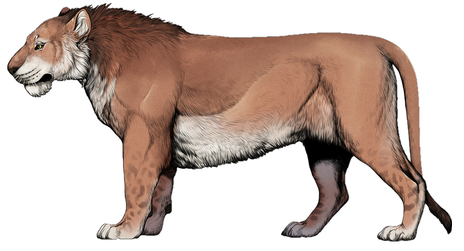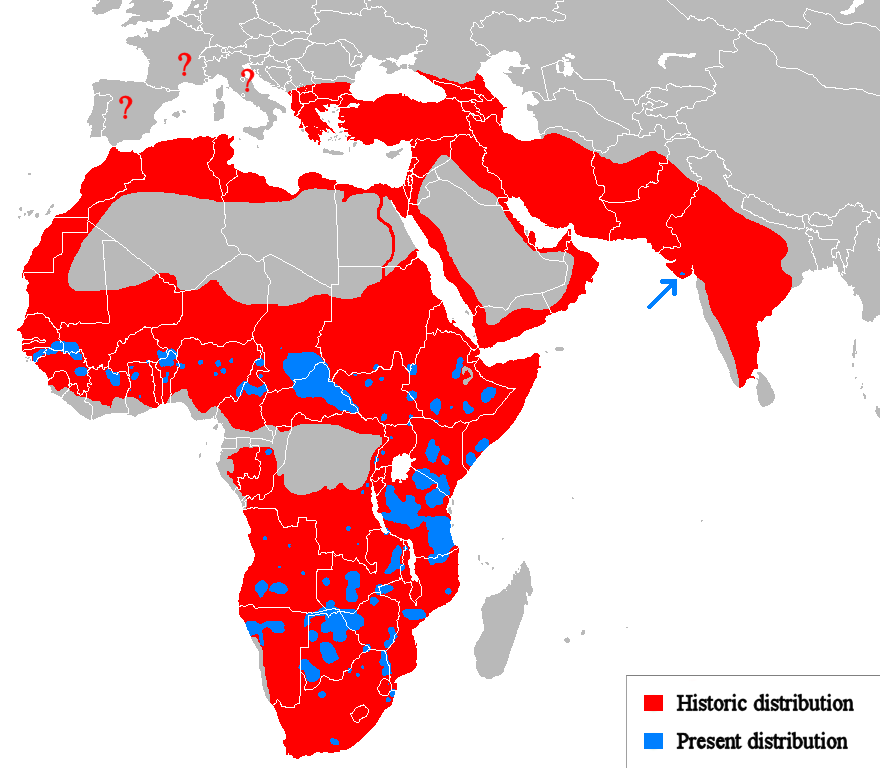|
Panthera Spelaea
''Panthera spelaea'', commonly known as the cave lion (or less commonly as the steppe lion), is an extinct ''Panthera'' species that was native to Eurasia and northwest North America during the Pleistocene epoch. Genetic analysis of ancient DNA has revealed that while closely related, it was a distinct species genetically isolated from the modern lion (''Panthera leo''), with the genetic divergence between the two species estimated at around 500,000 years ago. The earliest fossils of the ''P. spelaea'' lineage (either regarded as the separate species ''Panthera fossilis'' or the subspecies ''P. spelaea fossilis'') in Eurasia date to around 700,000 years ago (with possible late Early Pleistocene records). It is closely related and probably ancestral to the American lion (''Panthera atrox''). The species ranged from Western Europe to eastern Beringia in North America, and was a prominent member of the mammoth steppe fauna, and an important apex predator across its range along wit ... [...More Info...] [...Related Items...] OR: [Wikipedia] [Google] [Baidu] |
Chibanian
The Chibanian, more widely known as the Middle Pleistocene (its previous informal name), is an Age (geology), age in the international geologic timescale or a Stage (stratigraphy), stage in chronostratigraphy, being a division of the Pleistocene Epoch within the ongoing Quaternary Period. The Chibanian name was officially ratified in January 2020. It is currently estimated to span the time between 0.7741 annum, Ma (774,100 years ago) and 0.129 Ma (129,000 years ago), also expressed as 774.1–129 ka. It includes the transition in palaeoanthropology from the Lower Paleolithic, Lower to the Middle Paleolithic over 300 ka. The Chibanian is preceded by the Calabrian (stage), Calabrian and succeeded by the Late Pleistocene. The beginning of the Chibanian is the Brunhes–Matuyama reversal, when the Earth's magnetic field last underwent reversal. Its end roughly coincides with the termination of the Penultimate Glacial Period and the onset of the Last Interglacial period (correspondin ... [...More Info...] [...Related Items...] OR: [Wikipedia] [Google] [Baidu] |
Mammoth Steppe
The mammoth steppe, also known as steppe-tundra, was once the Earth's most extensive biome. During glacial periods in the later Pleistocene, it stretched east-to-west, from the Iberian Peninsula in the west of Europe, then across Eurasia and through Beringia (the region including the far northeast of Siberia, Alaska and the now submerged land between them) and into the Yukon in northwest Canada; from north-to-south, the steppe reached from the Arctic southward to southern Europe, Central Asia and northern China. The mammoth steppe was cold and dry, and relatively featureless, though climate, topography, and geography varied considerably throughout. Certain areas of the biome—such as coastal areas—had wetter and milder climates than others. Some areas featured rivers which, through erosion, naturally created gorges, gulleys, or small glens. The continual glacial recession and advancement over millennia contributed more to the formation of larger valleys and different geographic ... [...More Info...] [...Related Items...] OR: [Wikipedia] [Google] [Baidu] |
Monograph
A monograph is generally a long-form work on one (usually scholarly) subject, or one aspect of a subject, typically created by a single author or artist (or, sometimes, by two or more authors). Traditionally it is in written form and published as a book, but it may be an artwork, audiovisual work, or exhibition made up of visual artworks. In library cataloguing, the word has a specific and broader meaning, while in the United States, the Food and Drug Administration uses the term to mean a set of published standards. Written works Academic works The English term ''monograph'' is derived from modern Latin , which has its root in Greek. In the English word, ''mono-'' means and ''-graph'' means . Unlike a textbook, which surveys the state of knowledge in a field, the main purpose of a monograph is to present primary research and original scholarship. This research is presented at length, distinguishing a monograph from an article. For these reasons, publication of a monograph ... [...More Info...] [...Related Items...] OR: [Wikipedia] [Google] [Baidu] |
Jaguar
The jaguar (''Panthera onca'') is a large felidae, cat species and the only extant taxon, living member of the genus ''Panthera'' that is native to the Americas. With a body length of up to and a weight of up to , it is the biggest cat species in the Americas and the List of largest cats, third largest in the world. Its distinctively marked Animal coat, coat features pale yellow to tan colored fur covered by spots that transition to Rosette (zoology), rosettes on the sides, although a melanistic black coat appears in some individuals. The jaguar's powerful bite allows it to pierce the Turtle shell#Carapace, carapaces of turtles and tortoises, and to employ an unusual killing method: it bites directly through the skull of mammalian prey between the ears to deliver a fatal blow to the brain. The modern jaguar's ancestors probably entered the Americas from Eurasia during the Early Pleistocene via the land bridge that once spanned the Bering Strait. Today, the jaguar's range ex ... [...More Info...] [...Related Items...] OR: [Wikipedia] [Google] [Baidu] |
Scientific Name
In Taxonomy (biology), taxonomy, binomial nomenclature ("two-term naming system"), also called binary nomenclature, is a formal system of naming species of living things by giving each a name composed of two parts, both of which use Latin grammar, Latin grammatical forms, although they can be based on words from other languages. Such a name is called a binomial name (often shortened to just "binomial"), a binomen, name, or a scientific name; more informally, it is also called a Latin name. In the International Code of Zoological Nomenclature (ICZN), the system is also called nomenclature, with an "n" before the "al" in "binominal", which is a typographic error, meaning "two-name naming system". The first part of the name – the ''generic name (biology), generic name'' – identifies the genus to which the species belongs, whereas the second part – the specific name or specific epithet – distinguishes the species within the genus. For example, modern humans belong to the ... [...More Info...] [...Related Items...] OR: [Wikipedia] [Google] [Baidu] |
Johan Friedrich Esper
{{disambiguation ...
Johan may refer to: * Johan (given name) * ''Johan'' (1921 film), a Swedish film directed by Mauritz Stiller * Johan (2005 film), a Dutch romantic comedy film * Johan (band), a Dutch pop-group ** ''Johan'' (album), a 1996 album by the group * Johan Peninsula, Ellesmere Island, Nunavut, Canada * Jo-Han, a manufacturer of plastic scale model kits See also * John (name) John ( ) is a common male name in the English language ultimately of Biblical Hebrew, Hebrew origin. The English form is from Middle English ''Ioon'', ''Ihon'', ''Iohn, Jan'' (mid-12c.), itself from Old French ''Jan'', ''Jean'', ''Jehan'' (Moder ... [...More Info...] [...Related Items...] OR: [Wikipedia] [Google] [Baidu] |
Bavaria
Bavaria, officially the Free State of Bavaria, is a States of Germany, state in the southeast of Germany. With an area of , it is the list of German states by area, largest German state by land area, comprising approximately 1/5 of the total land area of Germany, and with over 13.08 million inhabitants, it is the list of German states by population, second most populous German state, behind only North Rhine-Westphalia; however, due to its large land area, its population density is list of German states by population density, below the German average. Major cities include Munich (its capital and List of cities in Bavaria by population, largest city, which is also the list of cities in Germany by population, third largest city in Germany), Nuremberg, and Augsburg. The history of Bavaria includes its earliest settlement by Iron Age Celts, Celtic tribes, followed by the conquests of the Roman Empire in the 1st century BC, when the territory was incorporated into the provinces of Ra ... [...More Info...] [...Related Items...] OR: [Wikipedia] [Google] [Baidu] |
Panthera Leo Spelaea MHNT
''Panthera'' is a genus within the family Felidae, and one of two extant genera in the subfamily Pantherinae. It contains the largest living members of the cat family. There are five living species: the jaguar, leopard, lion, snow leopard and tiger. Numerous extinct species are also named, including the cave lion and American lion. Etymology The word derives from Classical Latin , itself from the Ancient Greek (). Characteristics In ''Panthera'' species, the dorsal profile of the skull is flattish or evenly convex. The frontal interorbital area is not noticeably elevated, and the area behind the elevation is less steeply sloped. The basic cranial axis is nearly horizontal. The inner chamber of the bullae is large, the outer small. The partition between them is close to the external auditory meatus. The convexly rounded chin is sloping. All ''Panthera'' species have an incompletely ossified hyoid bone and a specially adapted larynx with large vocal folds covered in a fibro- ... [...More Info...] [...Related Items...] OR: [Wikipedia] [Google] [Baidu] |
Quaternary Science Reviews
''Quaternary Science Reviews'' is a peer-reviewed scientific journal covering quaternary science. It was established in 1982 by Pergamon Press and is currently published by Elsevier. The editor-in-chief is C.V. Murray Wallace (University of Wollongong). According to the ''Journal Citation Reports'', the journal has a 2013 impact factor The impact factor (IF) or journal impact factor (JIF) of an academic journal is a type of journal ranking. Journals with higher impact factor values are considered more prestigious or important within their field. The Impact Factor of a journa ... of 4.571. References External links * Elsevier academic journals Biweekly journals English-language journals Academic journals established in 1982 Quaternary science journals Archaeology journals {{archaeology-journal-stub ... [...More Info...] [...Related Items...] OR: [Wikipedia] [Google] [Baidu] |
Neanderthals
Neanderthals ( ; ''Homo neanderthalensis'' or sometimes ''H. sapiens neanderthalensis'') are an extinction, extinct group of archaic humans who inhabited Europe and Western and Central Asia during the Middle Pleistocene, Middle to Late Pleistocene. Neanderthal extinction occurred roughly 40,000 years ago with the immigration of modern humans (Cro-Magnons), but Neanderthals in Gibraltar may have persisted for thousands of years longer. The first recognised Neanderthal fossil, Neanderthal 1, was discovered in 1856 in the Neander Valley, Germany. At first, Neanderthal 1 was considered to be one of the racial hierarchy, lower races in accord with historical race concepts. As more fossils were discovered through the early 20th century, Neanderthals became characterised most especially by Marcellin Boule as a unique species of underdeveloped human. By the mid-20th century, human evolution was described as progressing from an apelike ancestor, through a "Neanderthal phase", ending ... [...More Info...] [...Related Items...] OR: [Wikipedia] [Google] [Baidu] |



